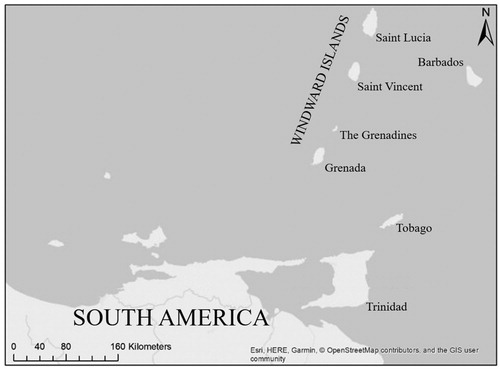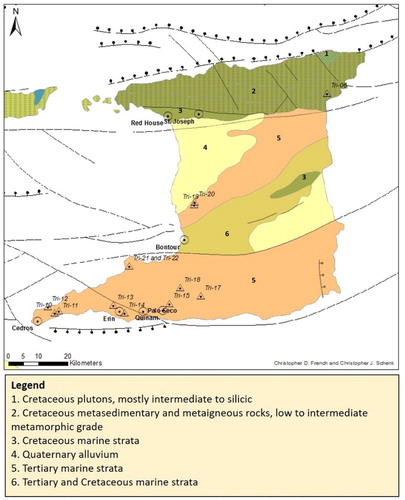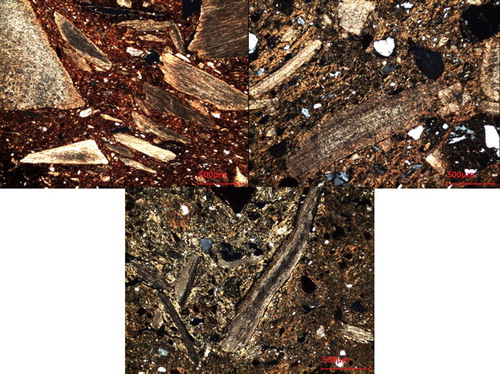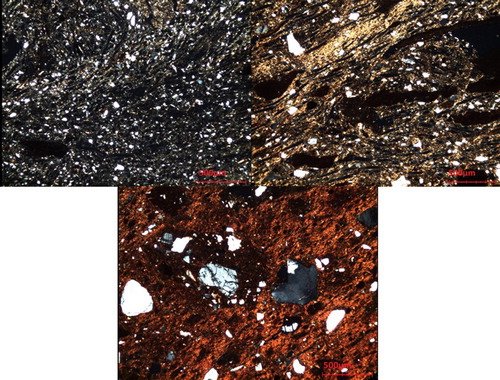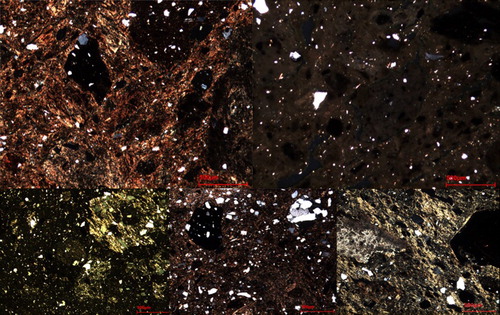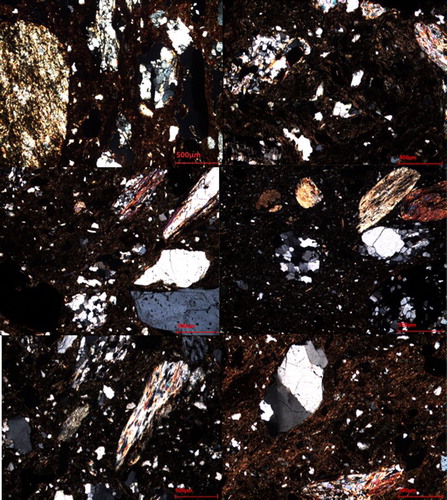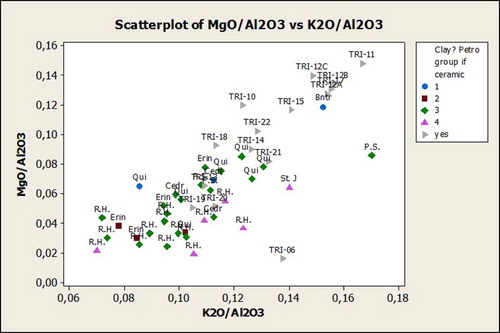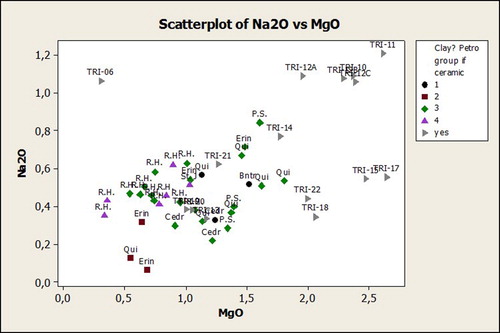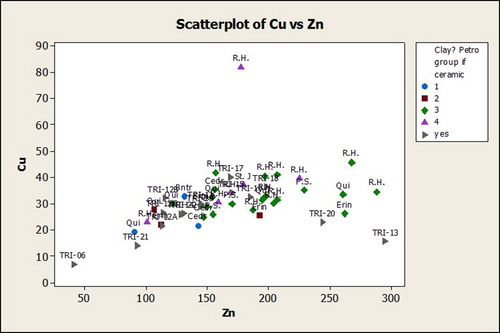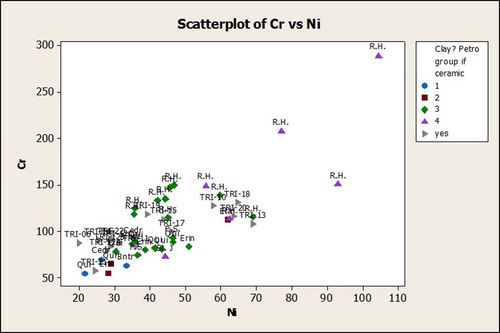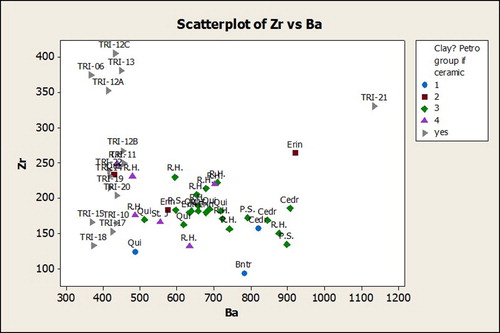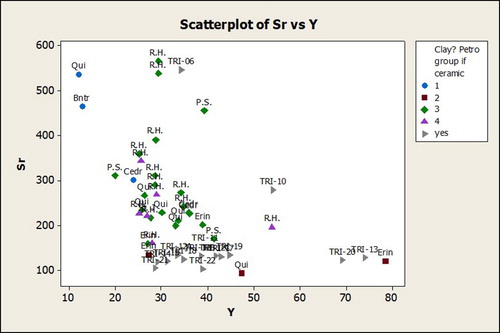ABSTRACT
This work presents an exploratory investigation into the production of pre-colonial ceramics found on Trinidad through petrography and chemical analysis with XRF and ICP-OES. Four main petrofabric groups are identified and described: a shell-tempered group, a sponge spicules group, a grog group and a micaschist/quartzite group. All evidence suggest an origin local to the island. Most of the petrofabric groups are consistent with ceramic series which were previously described, but never analysed petrographically and/or chemically.
GRAPHICAL ABSTRACT
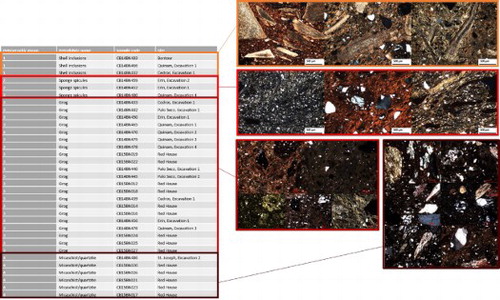
1. Introduction
Caribbean archaeology can look back on a rich research tradition. From the beginning of the discipline (mid to late nineteenth century) until roughly 1960, it was mostly concerned with describing, classifying and ordering artefacts, assemblages and sites to build large culture-historical typochronological sequences (Keegan and Hofman Citation2017, 17–20; Siegel Citation2013, 22). In this approach, the “culture-area concept”, which assumes that a culture is an adjustment to a particular environment, was the main tool to structure the archaeological data, along with “core–periphery relations” and migration waves (Siegel Citation2013, 23). Prime examples of this approach are J.W. Fewkes (Fewkes Citation1922) who defined twelve culture areas and three cultural epochs and M.R. Harrington (Harrington Citation1921) who postulated three waves of migration which populated the Caribbean. Perhaps the most influential figure in Caribbean Archaeology whose earlier work is also situated in this period, was Irving Rouse. His PhD thesis, Prehistory in Haiti: A Study in Method (Rouse Citation1939), proved a milestone for the field because it presented a way to classify and compare potentially related assemblages in a systematic way and because it introduced his method used to achieve this of modal analysis, which would for decades be frequently used, refined and debated both inside and outside of the field of Caribbean Archaeology (Siegel Citation2013, 24–25). Another milestone publication of this earlier period was that of F. Rainey (Rainey Citation1940) which focused on subsistence economics as a proxy to investigate cultural systematics and migrations, in his case of the so-called Crab and Shell cultures (Siegel Citation2013, 26–27).
As of 1961, a widening of research interests in the field of Caribbean Archaeology took place. Although many scholars, even to this day, still perform(ed) research belonging to the culture-historical paradigm, new areas of research such as time–space systematics, ethnohistory/ethnoarchaeology, symbolism/religion, archaeometric artefact analysis and provenance studies, physical anthropology, cultural heritage, environmental studiesand studies into socio-political organisation saw the light of day between 1961 and today and especially since ca. 2000 (Siegel Citation2013, 27–28).
Despite this rich research tradition, there is still a significant knowledge gap concerning the archaeometric investigation of ceramics from the region. Except the work presented in the special volume of 2008 in the Journal of Caribbean Archaeology, e.g. Conrad Citation2008; Crock Citation2008; Descantes, Speakman, and Glascock Citation2008; Fitzpatrick, Carstensen, and Marsaglia Citation2008; Hauser, Descantes, and Glascock Citation2008; Isendoorn, Hofman, and Booden Citation2008; Kelly Citation2008, very little archaeometric work on ceramics of the region has been published to date, with the notable exceptions of Pavia, Marsaglia, and Fitzpatrick Citation2013; Ting Citation2016; Lawrence, Marsaglia, and Fitzpatrick Citation2016; Scott Citation2018 and Ting Citation2018. Moreover, despite the fact that ceramics from Trinidad have been extensively studied in the past, e.g. Boomert Citation2000; Boomert, Faber-Morse, and Rouse Citation2013, none of the aforementioned archaeometric studies relate to ceramics from Trinidad.
Therefore, this article will construct an archaeometric baseline for Trinidad ceramics using a combination of thin section petrography and chemical analysis of both ceramics and clay samples from the island. This baseline will enable provenancing of Trinidad ceramics, from which further archaeological insights in terms of production and consumption patterns and related cultural processes can be construed. It will also be a useful addition to archaeometric data of the region, enabling further inter-island comparisons of pre-colonial Caribbean ceramics.
1.1. Geological and geographical setting
Trinidad is the southernmost island of the Lesser Antilles, with an area of approximately 4,828 km². It is situated just 12 km from South America (Venezuela), with which it was connected until the late Pleistocene/early Holocene (Boomert Citation2000, 17; Boomert Citation2014; Keegan, Hofman, and Ramos Citation2013, 5). shows the geographical relation between Trinidad, the South American mainland and the surrounding islands of the Lesser Antilles.
The Caribbean is a region which displays a high geological complexity with several plate boundary interactions, subduction zones, divergent plate boundaries and volcanism. It consists of four geological provinces with numerous subdivisions, of which the provinces of the Eastern Caribbean (Lesser Antilles and Barbados Ridge) and Northern South America (Venezuelan borderland) are the most relevant here.
The volcanic arc of the Lesser Antilles is a double arc system made up of a series of islands from Grenada in the south to the Anegada Passage between Anguilla and the Virgin Islands in the north. From Grenada up to Martinique, these two volcanic arcs are superimposed, whereas from Martinique northwards, the arc splits into an outer ridge with limestones (Limestone Caribbees) and an inner volcanic ridge. This inner ridge is a continuation of the volcanic Windward islands. The Windward islands and the inner ridge together form the Volcanic Caribbees (Draper, Jackson, and Donovan Citation1994, 8).
The Barbados Ridge is a forearc ridge which only emerges above sea level at the island of Barbados and is capped with limestones and deformed sedimentary rocks (Draper, Jackson, and Donovan Citation1994, 8).
The Venezuelan borderland is part of a mountain belt which marks the boundary of the Caribbean and the South American plates. The Venezuelan Antilles contain weakly metamorphosed volcanic and sedimentary rocks. This extends into parts of Trinidad (Draper, Jackson, and Donovan Citation1994, 9).
Trinidad itself is made up of five physiographic regions: the Northern Range, Northern Basin, Central Range, Southern Basin and Southern Range. The Northern Range consists of lower greenschist facies produced by the emplacement of large sheets of Mesozoic metavolcanics and metasediments into Paleogene flysch. It is subdivided into various formations consisting of limestones, (calcareous) phyllites, quartzites, slates, shales and sandstones. It also contains the only major outcrop of igneous rocks on Trinidad: the Sans Souci Formation. This formation consists of basalts and gabbros alongside sedimentary rocks (limestones, shales, sandstones and conglomerates). The other 4 regions can be grouped under the denominator of the “Trinidad Province”, which is a series of superimposed and deformed sedimentary basins with Cretateous carbonates and clastics, Paleogene flysch and Neogene marine and deltaic sediments. The series is disrupted by mud diapirs. Conglomerates, various types of clays, silts and sands, limestones, lignites, ironstone, arkosic quartzites, marls and mudstones, cherts and silicified wood can be encountered in the various formations of the Trinidad Province (Donovan Citation1994; Weber, Ferrill, and Roden-Tice Citation2001).
presents an overview of Trinidad’s surface geology, along with the location of the sites and clay sampling locations of this investigation.
1.2. Chronological overview
Trinidad already shows signs of occupation from about 6000 BC (Ramos and Pagan-Jimenez Citation2013; Pagán-Jiménez Citation2015), with the pre-ceramic Ortoiroid series (Boomert Citation2016, 17). During the last centuries BC, a gradual arrival of the first ceramic “culture”, the Saladoid, is visible. It is unknown whether there was still an Ortoiroid presence on the island at this time, so the mechanism of ceramic introduction on the island is unclear. It is clear, however, that the spread of the Saladoid in the wider region was rapid and that they maintained strong inter-island interactions, resulting in a great uniformity in pottery despite some regional stylistic differences (Boomert Citation2000; Hofman and Reid Citation2014, 300–304). Important Saladoid sites on Trinidad are Palo Seco and Cedros, although Saladoid ceramics have been recovered from all across the island. Exchange with and gradual adoption of other ceramic traditions, such as the Barrancoid of the Lower Orinoco on the South American continent are also visible from the first centuries AD. These interactions are to be found especially on the island’s southwestern littoral at the sites of Erin and Quinam. At these sites, Barrancoid ceramics are found in close association with Late Palo Seco Saladoid ceramics, potentially suggesting that both wares were manufactured and used largely simultaneously. In terms of ceramic recipe Barrancoid pottery is frequently tempered with particles of deliberately crushed quartz. Erin ceramics, the local manifestation of the Barrancoid series, tend to be tempered with deliberately crushed quartz, fine quartz sand, sponge spicules, or a combination of both (Boomert Citation2000, 127–217).
In the period between ca. AD 500 and 700, great dynamism is perceived in the South Caribbean. In Bontour, shell-tempered ceramics with minimal decoration emerge which are quite distinct from the Saladoid-Barrancoid material, marking the transition to the Arauquinoid (Boomert Citation2000, 127–217; Boomert Citation2013, 141–149).
The final pre-contact ceramic series in Trinidad is the Mayoid, that was tempered with caraipé, a type of tree bark (Boomert Citation2010; Boomert Citation2013, 149–152).
shows a summary of the main ceramic pre-contact series of the island.
Figure 3. Summary pre-contact ceramic age chronological chart based on 14C dates. Adapted from Boomert Citation2000, 128.
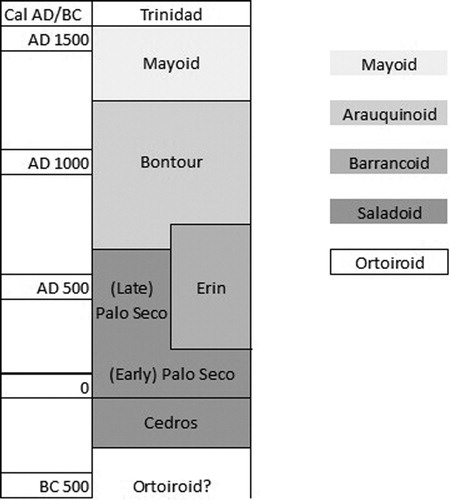
1.3. Archaeological contexts
1.3.1. Cedros
Cedros is the type site of the Cedrosan subseries of the Saladoid and consists of a series of shell midden deposits which measure at least 0.85 ha in total. It was discovered by oil geologists in 1923 and afterwards excavated by Rouse in 1946. The deposits consisted of shells, Cedrosan Saladoid pottery, stone, bone and charcoal. In the top levels, some transitional ceramics to the Palo Seco complex were encountered. In addition, charcoal samples for radiocarbon dating were taken which yielded dates of 2140 +/– 70 BP (378–2 calBCFootnote1) as the earliest and 1850 +/− 80 BP (18 calBC – 380 calAD) as the latest date (Boomert, Faber-Morse, and Rouse Citation2013, 19–25).
1.3.2. Palo Seco
Palo Seco is a multicomponent site and the type site of the Palo Seco complex, Cedrosan subseries, Saladoid series. A number of distinct shell middens were encountered. These middens showed a stratification of two layers, of which the bottom layer yielded pottery, stone, bone and shell artefacts exclusively of the Palo Seco complex whereas the upper stratum additionally contained some ceramics of the Erin (Barrancoid) and Bontour (Arauquinoid) complexes. A fragment of charcoal found in association with Cedros ceramics at the site yielded a radiocarbon date of 2060 +/− 80 BP (357 calBC – 119 calAD) and charcoal recovered in association with Palo Seco pottery yielded both slightly later dates of 1990 +/− 70 BP (194 calBC – 208 calAD) and 1480 +/− 70 BP (424–660 calAD) and a slightly earlier one of 2130 +/−80 BP (378 calBC – 6 calAD), although this last result may have been due to post-depositional factors (Boomert, Faber-Morse, and Rouse Citation2013, 25–30).
1.3.3. Quinam
The site of Quinam consists of three separate shell refuse deposits consisting of Palo Seco and Erin complex ceramics associated with similar material as on the previous sites. In another test pit at the same site but in a different midden, nearly 500 Bontour complex sherds were found (Boomert, Faber-Morse, and Rouse Citation2013, 30–35).
1.3.4. Erin
A multicomponent shell midden deposit measuring 260 m by 142 m was found in Erin which contained Erin and Palo Seco complex pottery next to stone and bone artefacts. In addition, a few Bontour complex pieces were found in the top levels of the midden (Boomert, Faber-Morse, and Rouse Citation2013, 40–42).
1.3.5. Bontour
Bontour is the type site of the Bontour complex and is also a shell midden deposit. Unlike the other middens discussed in this article, Bontour is not a multicomponent midden with multiple types of ceramics (Boomert, Faber-Morse, and Rouse Citation2013, 42–47).
1.3.6. St. Joseph
St. Joseph contains both pre-colonial and colonial remains. A 50 m by 50 m shell midden yielded pre-colonial Bontour complex ceramics as well as historic period Amerindian Mayo ceramics and European materials (Boomert, Faber-Morse, and Rouse Citation2013, 47–52).
1.3.7. Red House
As in St. Joseph, both pre-colonial and colonial ceramics have been found in Red House. The pre-colonial material found at the site is mostly Saladoid (Reid Citation2015).
2. Materials and methods
For this study, a combination of petrographic and chemical analysis was used. Thirty-three thin sections were examined, made from ceramics stemming from various locations on the island of Trinidad and all having a pre-contact date. Of these thin sections, one was made of a sherd from Bontour, one from St. Joseph, three from Cedros, three from Palo Seco, four from Erin, seven from Quinam and fourteen from Red House. All ceramics except the pieces from Red House were excavated by Rouse in 1946 or 1953 and curated in the Yale Peabody Museum until they were sampled by Boomert for archaeometric investigation. The material from Red House was donated by Reid from the collection of the University of the West Indies (Boomert, pers. comm.).
Different fabrics were isolated petrographically and afterwards representative thin sections for each fabric group were described in detail, using a descriptive method adapted from Whitbread (Whitbread Citation1995) and Quinn (Quinn Citation2013) and using reference charts for quantification of inclusion percentages. It was decided to keep the descriptions qualitative and to not use point counting because facilities needed for this technique were not readily available in the lab and the qualitative descriptions would later be complemented with quantitative chemical data, rendering much of the potential added value of point counting superfluous. Short comments about important differences between the described sample and the others within the petrographic group are included in the descriptions when applicable.
Normalised chemical data from powdered and homogenised samples obtained with XRF was provided by VU Amsterdam for the ceramic samples beginning with CB14 and the clays analysed, along with GPS-coordinates of the clay sampling locations. For the clays, this consisted of 22 samples whose locations are included in the map in section 1.1. In addition, ICP-OES analyses were executed at KU Leuven on the ceramic samples beginning with CB15 with a VARIAN 720-ES coupled with a VARIAN SPS 3 and ICP Expert II software. The operating conditions were 1.30 kW, 15 L/min plasma flow,1.5 L/min auxiliary flow and 0.75 L/min nebulizer flow, 3 s replication read time, a 60 s sample uptake delay and 15 s instrument stabilisation delay, a rinse time of 10 s and 3 replicates per measurement. PRI 1, GBW 7411, BCS 269, BCS 267, NIST 610 and NIST 612 were run as standards. The minimum correlation coefficient was set at 0.99.
XRF and later ICP-OES were selected as analytical techniques because they are destructive techniques which allow sample homogenisation and they give bulk chemistry results with the desired precision and accuracy (ppm range), see, e.g. Price and Burton Citation2012, 84–88; Isendoorn, Hofman, and Booden Citation2008; Vyncke Citation2011; Braekmans Citation2017. Moreover, they are in line with previous and future analyses within the research project and measuring facilities are available on-site.
The data obtained was then sorted according to the groups which were identified with thin-section analysis. The major element data was then first examined visually for striking inter- and intra- group differences or similarities. Afterwards, scatterplots were generated using Minitab 16 to assess this initial examination graphically. A similar procedure was used for the trace elements.
The online module of OxCal with calibration curve IntCal 13 was used for the calibration of the radiocarbon dates mentioned in the introduction.
3. Results
3.1. Petrographic analysis
Four main groups were identified, a shell inclusions group (N=3), a sponge spicules group (N=3), a grog group (N=21) and a micaschist/quartzite group (N=6). There does not seem to be a strong correlation between findspot and petrofabric group, except that the metamorphic group only contained samples from Red House and one sample from St. Joseph. In the following paragraphs, the different fabrics will be described in detail. shows which samples are included in which group. The samples in bold italics are fully described.
Table 1. Overview of the thin sections.
Relative frequencies of inclusions and voids are determined using a percentage area reference chart and described using the terms shown in .
Table 2. Relative frequencies of inclusions and voids.
3.1.1. Shell inclusions group (N=3)
The sample from this group which is described in detail is CB14BN483 from Bontour. In terms of microstructure, the section contains very few (2–5%) voids of ca. 0.5 mm which are almost exclusively shrinkage voids around inclusions. The voids have a variable shape and roundness. The elongate inclusions and the elongate non-shrinkage voids which are present show an alignment to the edge of the sample. The matrix is optically active and has a pale to orange/brown colour. In terms of inclusions, the section contains 30% coarse fraction (>0.5 mm), 65% fine fraction (<0.5 mm) and 5% voids. The inclusions are angular and either very equant or very elongate. The size of the coarse fraction varies between 0.5 and 2.5 mm, with a mode of ca. 1.2 mm. The distribution of the inclusions is bimodal. The predominant, indeed almost exclusive, type of inclusion are shell fragments, conforming to the aforementioned characteristics. Apart from shell fragments, there are also very few (2–5%) argillaceous inclusions (clay pellets) present which are rounded and spherical. Their maximum size is ca. 1.2 mm and their modal size ca. 1 mm. The fine fraction consists almost exclusively of quartz and small calcareous fragments which are equant and angular.
In the other two samples from this fabric, shell is frequent (30–50%) rather than predominant (>70%). Other inclusions in these sections are grog (few) and limestone (few). CB14BN432 also contains very few (2–5%) plagioclase.
A photomicrograph under crossed polars of these three sections is included in .
3.1.2. Sponge spicules group (N=3)
For this group, sample CB14BN459 from Erin is described in detail. Microstructurally, the sample contains voids between 0.2 and 2 mm in size which are mostly shrinkage voids of variable shape. There are so few inclusions that any alignment is impossible to detect. The matrix is optically active and light in colour. Moreover, it contains many very small fossils (smaller than 0.1 mm), most of which are completely circular, but some of which are elongate. These fossils are interpreted as sponge spicules. In terms of inclusions, the coarse:fine:voids (c:f:v:) ratio is 5:90:5, with fine fraction defined as inclusions smaller than 0.5 mm and matrix. The inclusions are sub-prismoidal or spherical and sub-rounded and the size of the coarse fraction ranges from 0.5 to 2 mm. The distribution is unimodal. In the coarse fraction, quartz is common (15–30%) and is elongate and rounded. The maximum size is ca. 1 mm and the modal size ca. 0.9 mm. Larger fossils and organic inclusions, the latter of which are visible from charring around some voids, are also common. Their shapes are variable and ill-defined and they have a maximum size of ca. 2 mm. Argillaceous inclusions (clay pellets and possibly mudstone or grog) are rare (0.5–2%) and also have an ill-defined shape and maximum size of ca. 2 mm. The fine fraction consists almost exclusively of quartz which is equant and angular.
The other samples from the group contain elongate rather than circular spicules and the matrix is orange rather than pale. In CB14BN480, a more or less parallel alignment to the edge of the sample can be detected. Otherwise, it is similar to CB14BN459. CB14BN452 displays only common (15–30%) spicules and common grog, so it is slightly ambiguous whether this sample should be included in this group or in the grog group. shows the sections under crossed polars.
3.1.3. Grog group (N=21)
This petrofabric group is internally heterogeneous. Sections CB15BN014 and CN15BN016 are described in detail as they represent the two main subgroups, of which subgroup 1 contains the majority of the samples (N=14) and subgroup 2 contains three samples: CB15BN016, CB15BN025 and CB15BN027. There are also three samples which deviate from the two main subgroups: CB15BN012, CB15BN024 and CB14BN439. CB15BN012 is similar to subgroup 2 but is also enriched in mica. The other two are similar to subgroup 1 but CB15BN024 contains large quartz inclusions and is enriched in mica and CB14BN439 contains lime-rich inclusions. Another interesting thing to note is that in many of the samples from subgroup 1, grog resembling the reducing part of subgroup 2 samples is present.
The microstructure of CB15BN014 contains voids of 0.5–1 mm, some of which are (sub-)discoidal and sub-angular while others are spherical and sub-angular. No alignment is visible. The matrix is light brown in PPL and yellowish orange in XP and is optically active. Some structures which resemble clay mixing – either intentional or natural – with a more grey/beige clay can be detected. However, these are probably soil textures rather than mixing (Neyt pers. comm.). The c:f:v ratio of the inclusions is 20:75:5 and the texture of the inclusions is sub-prismoidal or spherical and sub-rounded. The size of the coarse fraction ranges between 0.5–3.5 mm, with a modal size of ca. 0.7 mm. The distribution of the inclusions is bimodal and they are moderately well sorted. Grog is frequent to dominant (ca. 50%) and is equant and angular in shape. Its maximum size is ca. 3 mm and its modal size is ca. 0.7 mm. Other argillaceous fragments are few to common (ca.15%) and are equant and sub-angular. The maximum size is ca. 1.9 mm and the modal size ca. 1.2 mm. There are very few (2–5%) quartz inclusions present in the coarse fraction which are elongate and angular in shape and have a maximum size of ca. 1.2 mm and a modal size of ca. 1 mm. The inclusions in the fine fraction consist almost exclusively of quartz which is equant and angular with a size smaller than 0.5 mm.
The microstructure of CB15BN016 has voids which are ca. 0.05–0.6 mm in size and are either planar voids or vughs. No real alignment is visible, but the planar voids often occur along the rims of inclusions. Some optical activity of the matrix is visible in the oxidising region around the border of the sample, but the rest of the sample is optically inactive. The groundmass is grey with a yellow/orange border. In terms of inclusions, the section contains about 10% coarse fraction, 85% fine fraction and 5% voids, rendering the matrix very fine. The texture of the inclusions of the coarse fraction is sub-prismoidal or spherical and sub-rounded. The size of the inclusions of the coarse fraction ranges between ca. 0.5–1.8 mm, of which inclusions of ca. 0.7 mm are the most abundant. The coarse fraction is mostly situated in the oxidising border region. The distribution of the inclusions is bimodal and moderately well sorted. Grog and/or other argillaceous inclusions (clay pellets and mudstone) are frequent to dominant (ca. 50%) and the grog is equant and angular. The maximum size is ca. 1.8 mm and the modal size is ca. 0.7 mm. Distinguishing between grog and the other argillaceous inclusions is difficult. Quartz is frequent to dominant and comes in varying degrees of sphericity and roundness. The maximum size is ca. 1.2 mm and the modal size ca. 0.7 mm. The fine fraction is almost exclusively quartz conforming to earlier descriptions.
Pictures are included () of the two described samples and the three samples displaying variations in XP.
3.1.4. Micaschist/quartzite group (N=6)
The sample which is fully described for this group is CB14BN486. In terms of microstructure, it has voids of 0.5–3 mm, most of which are shrinkage voids of irregular shape. Other smaller voids are spherical and sub-angular. The alignment of voids and elongate inclusions is fairly parallel to the border of the sample. The matrix is optically active and orange/brown. In terms of inclusions, the c:f:v ratio is 20:70:10 and the inclusions of the coarse fraction are angular and elongate. The largest inclusions are ca. 3 mm and the mode of the coarse fraction is ca. 1.2 mm. The distribution is bimodal. Micaschist and quartzite are frequent to dominant (ca. 50%) and elongate and angular. The sample contains both inclusion types in more or less equal quantities. Their maximum and modal size corresponds to the general coarse fraction description. In the coarse fraction, there are also rare to few (<10%) argillaceous inclusions (clay pellets) present which tend to be elongate with varying roundedness. Their maximum size is ca. 2 mm and their modal size ca. 1 mm. The fine fraction is mostly quartzite which is equant and angular with a size smaller than 0.5 mm.
In CB15BN021 and CB15BN023, quartzite is more abundant than micaschist. CB15BN017 also contains abundant quartz in addition to quartzite and micaschist, but the fine fraction is more pronounced with a c:f:v ratio of 10:80:10. presents an overview of all six sections in XP and low magnification. Also note that the more or less parallel alignment is not visible in the other sections. Indeed, CB15BN020 displays a coil-like pattern instead.
3.2. Chemical analysis
3.2.1. Major elements
shows the major oxide data for sampled clay sources and ceramics. The most obvious characteristic is that the CaO values of the shell tempered group are much higher than for the other fabrics or the clays, compensated for by much lower SiO2-concentrations (closed sum). The samples of group 2 are also chemically consistent apart from sample CB14BN452. As noted before, the assignment of the latter to either group 2 or 3 is ambiguous and this is reflected in its chemical composition, which is far more comparable to group 3 than to group 2 (e.g. lower amounts of Na2O and Fe2O3), despite the presence of some sponge spicules. Apart from some individual elevated or low values (e.g. P2O5 values between 4–6 wt%), groups 3 and 4 appear to be similar, albeit internally heterogeneous. Since multiple measurements from the same clay deposit are not available, it is unknown whether this heterogeneity was already present from the source, or is due to clay treatment such as mixing.
Table 3. Major oxides of ceramics and clays.
The pattern visible on the scatterplots generated from the major element data appears to corroborate this picture. These plots are shown in and . Especially interesting is the scatterplot of MgO/Al2O3 vs. K2O/Al2O3, as these ratios could help to distinguish different clay sources. Apart from a Palo Seco outlier from group 3 (CB14BN440) and the TRI-06 clay source, all data points seem to cluster in a more or less elliptical cloud. The samples from group 1 are scattered quite widely apart within this cloud whereas the samples from groups 2, 3 and 4 cluster more tightly together within their respective groups, albeit with significant overlap between the groups. It is important to note however, that the chemical variability displayed in this plot is quite small and the overall differences between the data points are limited. There is significant overlap between many of the clay sources and the ceramic samples, although both ratios tend to be higher in the clay samples than in the ceramics. Some clays (e.g. TRI-11, TRI-12 and TRI-15) do plot outside of the main ceramic cluster.
3.2.2. Trace elements
Trace elements could aid in comparing the ceramics with potential clay sources. For most trace elements, the clay sources and the bulk of ceramic samples coincide nicely, as illustrated by and . There are some exceptions: Ba and Y for example tend to be significantly lower in the clay samples than in the ceramics ( and ). Ceramic samples from the same petrographic group tend to cluster together, but display a significant amount of overlap with the other groups. We can conclude that some of the clays and the ceramic groups are fairly homogeneous in terms of trace element compositions. This could be an argument against clay mixing.
4. Discussion
An important point of discussion is the comparison of the information generated from the thin section petrography and the chemical analyses, and the archaeological information about the ceramics.
It was mentioned earlier in this paper that Erin is important in the production of sponge and fine quartz tempered wares. CB14BN459 and CB14BN480 seem to corroborate this and confirm that such wares were also found in Quinam, which is situated approximately 17 km further to the east. Since many of the clay samples were chemically similar, it is impossible to assign a more specific production location on the island. Petrographic and chemical data are both consistent with local (surface) geology, so an origin local to the island is likely. In terms of this surface geology, both sites are situated within a Tertiary and Cretaceous marine stratum, as are all other sites except Red House, St. Joseph and Bontour and all clay sampling locations except TRI-06 and TRI-19/20. in the introduction presents an overview of the locations of the sites and clay sampling locations and the surface geology.
No information about a fabric tempered with metamorphic rocks was found in Boomert (Boomert Citation2000; Boomert Citation2013; Boomert Citation2016). If all investigated Red House sherds are indeed Saladoid, then for the first time in the current study there is a clear difference between the typological assignment of the sherds and their petrography, as these samples were petrographically very distinct from the other Saladoid material under consideration here. It could suggest that the Saladoid pottery production was very localised, since the surface geology map shows that Red House and St. Joseph are both situated close to a stratum with low to intermediate metamorphic rocks, suggesting local sand was used as temper and/or local clays were used. The only clay source from this stratum which was analysed, was TRI-06. However, this sample was taken quite far from the sites, which may be an explanation why the trace element compositions do not closely match. In fact, TRI-06 is an outlier for most major and trace elements. There is significant overlap with other clays sampled from the island suggesting a local origin, while the metamorphic inclusions strongly hint at production in the north of the island.
Fabric group 3 (grog) was found on nearly all sites studied and can probably be assigned to the Saladoid type as Boomert (Boomert Citation2000) points out that grog temper occurs on the island during the Saladoid period. This may also explain why this group was represented in thin sections from all sites studied here except Bontour and St. Joseph, as these ceramics displayed a wide distribution (Boomert Citation2000, 127–169). The trace element composition is consistent with an origin local to the island.
Due to the fact that the compositional ranges for both major and trace elements are fairly narrow for all ceramics and clays investigated in this study, it may prove possible in future research to use this typical “Trinidad” signature when executing inter-island comparisons.
The fact that all Trinidad ceramics studied here are consistent with a local signature is interesting. Nearly all of the other pre-colonial ceramic assemblages from islands of the Lesser Antilles which have undergone provenance determinations, showed at least a mixture of locally produced and imported wares (Crock Citation2008; Fitzpatrick, Carstensen, and Marsaglia Citation2008; Isendoorn, Hofman, and Booden Citation2008; Pavia, Marsaglia, and Fitzpatrick Citation2013; Lawrence, Marsaglia, and Fitzpatrick Citation2016; Scott Citation2018). The Saladoid may have found its way into the other Lesser Antillean islands from its origins in the American mainland trough Trinidad and stylistically shows similarities across all the islands of the Lesser Antilles where it is attested (Hofman and Reid Citation2014; Boomert Citation2014), but it is currently still unclear how deeply this uniformity permeates into the very fabrics. This would form interesting source material for further study, as would a comparison with other artefact types. Boomert (Citation2013, 144) notes in this respect that at least ornaments of semi-precious rock fragments found on both Trinidad, Tobago and the Windward islands point towards intensive interaction during Saladoid times. For later pre-contact periods, the apparent lack of interaction with the rest of the Lesser Antilles is less surprising since post-Saladoid Trinidad typologically shows larger affiliations with the Venezuelan mainland (Boomert Citation2014). This is also evidenced by the fact that the Barrancoid, Arauquinoid and Mayoid series originally had mainland origins and that e.g. during the Arauquinoid period, exchange objects from the mainland can be found on Trinidad and that the main tempering material during the Mayoid, caraipé (burnt tree bark), is typical of the Lokono in the Guianas (Boomert Citation2014, 337–338).
5. Conclusion
Through a combination of information from literature, thin section analysis and chemical analysis, it was possible to sketch a clearer picture on the manufacturing of Trinidad’s pre-colonial ceramics. In this paper, four main ceramic groups were identified in thin section, of which all groups corresponded to groups described previously in the literature. Moreover, it was seen that apart from the metamorphic group, which appears to be local to the north of the island to sites such as Red House and St. Joseph, samples from the other groups appear on multiple sites. It is, however, problematic that no more detailed chronology is available as this makes it very difficult to decide whether for instance the presence of both group 3 and group 4 ceramics in Red House is due to certain contemporaneous consumption patterns, or simply signifies a change through time. Despite restricted sample size, the combination of petrographic and chemical analyses together with information from surface geology suggests that a production local to the island is probable for all ceramics studied. Moreover, the “Trinidad” chemical signature defined here will be useful for further archaeometric investigations of Caribbean ceramics and clays since it fills a blank spot in archaeometric ceramic data from the Lesser Antillean region.
Acknowledgements
The results presented here are an outcome of the CARIB project “Caribbean connections: cultural encounters in a New World setting” financed by the Humanities in the European Research Area (HERA grant number: 1133), of the NEXUS1492 ERC-Synergy Project from the European Research Council under the EU’s 7th Framework Programme (FP7/2007-2013) / ERC grant agreement n° 319209 and the NWO grant “Island Networks: modelling inter-community social relationships in the Lesser Antilles across the historical divide (AD 1000-1800)” (NOW grant # 360-62-060). Furthermore, we would like to extend our thanks to Daan Isendoorn for the collection of some of the ceramic and clay samples and to Herman Nijs, Steven Luypaers and Elvira Vassilieva for preparation of thin sections and ICP-OES analyses. Our gratitude also goes out to Arie Boomert for his valuable comments on the archaeology of Trinidad.
Disclosure statement
No potential conflict of interest was reported by the authors.
Notes on contributors
Anneleen Stienaers is PhD researcher at KU Leuven and Leiden University studying continuity and change in the ceramic repertoire of the Caribbean from an archaeometric viewpoint. Prior to her current position, she completed a BA in Archaeology at KU Leuven (2015) and an MSC Experimental Archaeology at the University of Sheffield (2016) with a dissertation titled: “Concerning crucibles: the influence of ceramic containers on Egyptian and Roman soda glasses.”
Bert Neyt was a Post-doctoral researcher at KU Leuven until 2016, where he compiled a database of petrographic and chemical analyses of pre-colonial ceramics of the Lesser Antilles.
Corinne Hofman is professor of Caribbean archaeology at the Leiden Faculty of Archaeology and the Royal Netherlands Institute of Southeast Asian and Caribbean Studies (KITLV) of the Royal Dutch Academy of Sciences (KNAW). After obtaining a BA degree in art history and archaeology at the Vrije Universiteit Brussels (VUB), she completed her MA in pre-Columbian archaeology in 1987 and her PhD in 1993 at Leiden University with a research focus on the Caribbean. Since then her research and teaching focusses on the archaeology and indigenous history of the Caribbean.
Patrick Degryse is professor at the department of Earth and Environmental Sciences and director of the Centre for Archaeological Sciences at the Katholieke Universiteit Leuven (Belgium), and professor of Archaeometry at the faculty of Archaeology in Leiden University (the Netherlands). His main research efforts focus on the history and use of mineral resources in ancient ceramic, glass, metal and building materials production, developing geochemical techniques for characterisation and provenancing.
Additional information
Funding
Notes
1 All calibrated dates with 95.5% confidence interval.
References
- Boomert, A. 2000. Trinidad, Tobago and the Lower Orinoco Interaction Sphere. An Archaeological/Ethnohistorical Study. Leiden: Universiteit Leiden.
- Boomert, A. 2010. “Crossing the Galleons’ Passage: Amerindian Interaction and Cultural (Dis)Unity Between Trinidad and Tobago.” Journal of Caribbean Archaeology 9 (Special Publication 3): 106–121.
- Boomert, A. 2013. “Gateway to the Mainland: Trinidad and Tobago.” In Oxford Handbook of Caribbean Archaeology, edited by W. F. Keegan, C. L. Hofman, and R. R. Ramos, 141–155. New York: Oxford University Press.
- Boomert, A. 2014. “Trinidad and Tobago.” In Encyclopedia of Caribbean Archaeology, edited by B. A. Reid, and R. G. Gilmore III, 335–339. Gainesville: University Press of Florida.
- Boomert, A. 2016. The Indigenous Peoples of Trinidad and Tobago. From the First Settlers Until Today. Leiden: Sidestone Press.
- Boomert, A., B. Faber-Morse, and I. Rouse. 2013. The 1946 and 1953 Yale University Excavations in Trinidad. New Haven, CT: Yale University publications in anthropology.
- Braekmans, D., P. Degryse, B. Neyt, M. Waelkens, and J. Poblome. 2017. “Reconstructing Regional Trajectories: The Provenance and Distribution of Archaic to Hellenistic Ceramics in Central Pisidia.” Archaeometry 59 (3, April 2016): 472–492. doi: 10.1111/arcm.12259
- Conrad, G. W., C. D. Beeker, C. Descantes, J. W. Foster, and M. D. Glascock. 2008. “Compositional Analysis of Ceramics From La Aleta, Dominican Republic: Implications for Site Function and Organization.” Journal of Caribbean Archaeology 8 (Special Publication 2): 57–68.
- Crock, J. G., B. F. Morse, C. Descantes, J. B. Petersen, and M. D. Glascock. 2008. “Preliminary Interpretations of Ceramic Compositional Analysis in Anguilla and the Salt River Site in St. Croix.” Journal of Caribbean Archaeology 8 (Special Publication 2): 57–68.
- Descantes, C., R. J. Speakman, and M. D. Glascock. 2008. “Compositional Studies of Caribbean Ceramics: An Introduction to Instrumental Neutron Activation Analysis.” Journal of Caribbean Archaeology (Special Publication 2): 57–68.
- Donovan, S. K. 1994. “Trinidad.” In Caribbean Geology. An Introduction, edited by S. K. Donovan and T. A. Jackson, 209–228. Kingston: UWIPA.
- Draper, G., T. Jackson, and S. Donovan. 1994. “Geologic Provinces of the Caribbean Region.” In Caribbean Geology. An Introduction, edited by S. Donovan and T. A. Jackson, 3–12. Kingston: UWIPA.
- Fewkes, J. W. 1922. “A Prehistoric Island Culture Area of America.” In 34th Annual Report of the Bureau of American Ethnology to the Secretary of the Smithsonian Institution for 1912–13. Washington, 35–271.
- Fitzpatrick, S. M., J. A. Carstensen, and K. M. Marsaglia. 2008. “Preliminary Petrographic and Chemical Analyses of Prehistoric Ceramics From Carriacou, West Indies.” Journal of Caribbean Archaeology 8 (Special Publication 2): 57–68.
- Harrington, M. R. 1921. Cuba Before Columbus. New York. Indian Notes and Monographs, Museum of the American Indian, Heye Foundation; Part I, Vol. II: Láms.
- Hauser, M. W., C. Descantes, and M. D. Glascock. 2008. “Locating Enslaved Craft Production: Chemical Analysis of Eighteenth Century Jamaican Potter.” Journal of Caribbean Archaeology 8 (Special Publication 2): 123–148.
- Hofman, C. L., and B. A. Reid. 2014. “The Saladoid.” In Encyclopedia of Caribbean Archaeology, edited by B. A. Reid and R. G. Gilmore III, 300–304. Gainesville: University Press of Florida.
- Isendoorn, A. J. D., C. L. Hofman, and M. Booden. 2008. “Back to the Source: Provenance Areas of Clays and Temper Materials of Pre-Columbian Caribbean Ceramics.” Journal of Caribbean Archaeology 8 (Special Publication 2): 15–24.
- Keegan, W. F., and C. L. Hofman. 2017. The Caribbean Before Columbus. New York: Oxford University Press.
- Keegan, W. F., C. L. Hofman, and R. R. Ramos. 2013. “Introduction.” In Oxford Handbook of Caribbean Archaeology, edited by W. F. Keegan, C. L. Hofman, and R. R. Ramos, 1–21. New York: Oxford University Press.
- Kelly, K. G., M. W. Hauser, C. Descantes, and M. D. Glascock. 2008. “Compositional Analysis of French Colonial Ceramics: Implications for Understanding Trade and Exchange.” Journal of Caribbean Archaeology 8 (Special Publication 2): 85–108.
- Lawrence, J. A., K. M. Marsaglia, and S. M. Fitzpatrick. 2016. “Petrographic Analysis of Pre-Columbian Pottery From Four Islands in the Lesser Antilles and Implications for Inter-Island Transport and Interactions.” Journal of Archaeological Science: Reports 9: 663–680. doi: 10.1016/j.jasrep.2016.08.033
- Pagán-Jiménez, J. R., Reniel Rodríguez-Ramos, Basil A. Reid, Martijn van den Bel, and Corinne L. Hofman. 2015. “Early Dispersals of Maize and Other Food Plants Into the Southern Caribbean and Northeastern South America.” Quaternary Science Reviews 123: 231–246. doi: 10.1016/j.quascirev.2015.07.005
- Pavia, J. A., K. M. Marsaglia, and S. M. Fitzpatrick. 2013. “Petrography and Provenance of Sand Temper Within Ceramic Sherds From Carriacou, Southern Grenadines, West Indies.” Geoarchaeology 28: 450–477. doi: 10.1002/gea.21449
- Price, D. T., and J. H. Burton. 2012. An Introduction to Archaeological Chemistry. Heidelberg: Springer.
- Quinn, P. S. 2013. Ceramic Petrography. The Interpretation of Archaeological Pottery & Related Artefacts in Thin Section. Oxford: Archaeopress.
- Rainey, F. 1940. Porto Rican Archaeology. New York: The New York Academy of Sciences.
- Ramos, R. R., and J. Pagan-Jimenez. 2013. “The Humanization of the Insular Caribbean.” In Oxford Handbook of Caribbean Archaeology, edited by W. F. Keegan, C. L. Hofman, and R. R. Ramos, 126–141. New York: Oxford University Press.
- Reid, B. A. 2015. Red House Restoration Archaeology Project. Trinidad.
- Rouse, I. 1939. Prehistory in Haiti : a Study in Method. New Haven, CT: Yale University Press.
- Scott, R. B., B. Neyt, C. Hofman, and P. Degryse. 2018. “Determining the Provenance of Cayo Pottery From Grenada, Lesser Antilles, Using Portable X-Ray Fluorescence Spectrometry.” Archaeometry 60 (5): 966–985. doi: 10.1111/arcm.12359
- Siegel, P. E. 2013. “Caribbean Archaeology in Historical Perspective.” In Oxford Handbook of Caribbean Archaeology, edited by W. F. Keegan, C. L. Hofman, and R. R. Ramos, 21–47. New York: Oxford University Press.
- Ting, C., Bert Neyt, Jorge Ulloa Hung, Corinne Hofman, and Patrick Degryse. 2016. “The Production of pre-Colonial Ceramics in Northwestern Hispaniola: A Technological Study of Meillacoid and Chicoid Ceramics From La Luperona and El Flaco, Dominican Republic.” Journal of Archaeological Science: Reports 6: 376–385. doi: 10.1016/j.jasrep.2016.02.031
- Ting, C., Jorge Ulloa Hung, Corinne L. Hofman, and Patrick Degryse. 2018. “Reports Indigenous Technologies and the Production of Early Colonial Ceramics in Dominican Republic.” Journal of Archaeological Science: Reports 17 (April 2017): 47–57. doi: 10.1016/j.jasrep.2017.10.035
- Vyncke, K., P. Degryse, E. Vassilieva, and M. Waelkens. 2011. “Identifying Domestic Functional Areas. Chemical Analysis of fl oor Sediments at the Classical-Hellenistic Settlement at Düzen Tepe (SW Turkey).” Journal of Archaeological Science 38 (9): 2274–2292. doi: 10.1016/j.jas.2011.03.034
- Weber, J., D. Ferrill, and M. Roden-Tice. 2001. “Calcite and Quartz Microstructural Geothermometry of low-Grade Metasedimentary Rocks, Northern Range, Trinidad.” Journal of Structural Geology 23: 93–112. doi: 10.1016/S0191-8141(00)00066-3
- Whitbread, I. K. 1995. Appendix 3 The Collection, Processing and Interpretation of Petrographic Data. In Greek Transport Amphorae: A Petrological and Archaeological Study. 365–396.

